Behaviour
Caring for babies
Bottle feeding
Changing a nappy
Cleaning and sterilising bottles
Daily cleaning tasks
Helping new children settle in
Preparing for a nappy change
Sleep patterns – babies
Sleep routines – babies
Toilet training
Caring for children
Allowing time for practice
Dressing/undressing
Mealtimes
Nappy change
Packing away/caring for the environment
Sleep/rest time
Toileting
Common self-help milestones
Tips for sleep and rest time
Self image
Communication
Body language
Limits and guidelines
Ways children communicate
Greeting children and families
Modelling appropriate communication
Questioning
Verbal and non–verbal communication
Acknowledging children's feelings
Listening attentively
Communicating with Aboriginal and Torres Strait Islander parents/carers
Development
Allowing time for practice
Dressing/undressing
Mealtimes
Nappy change
Packing away/caring for the environment
Sleep/rest time
Toileting
Common self-help milestones
Creative development
Language development
Modelling positive relationships
Physical development
Sharing and taking turns
Sleep patterns – babies
Sleep routines – babies
Encourage independent problem solving
Fundamental movement skills
Health, hygiene and safety
Coping with stress
Correct manual handling principles
Daily cleaning tasks
Hand washing
Hand washing poster
Manual handling overview
Toilet training
Safety checklist
Learning experiences and play
Environmentally friendly learning experiences
Learning experiences for different development areas
Creative resource materials
Arranging the environment to facilitate learning and pleasure
Indoors and outdoor areas
Creating a positive physical environment
Legal and ethical issues
Child abuse case studies
How do I recognise when a child or young person is at risk?
Tips on dealing with disclosures
Observation methods
Arranging Experiences (PDF 351Kb)
Recording observations
Rules for making observations
What you can learn from observations
Programming
Children’s interests, strengths, needs and skills
Extending the children’s interest in dinosaurs
Objective observation
Planning an OSHC environment
Behavior management plan
Planning enjoyable experiences
Planning experiences for 0 - 2 years age group
Planning experiences for 2 - 3 years age group
Planning experiences for 3 - 5 years age group
Changing a nappy
Once you have the right equipment and a suitable place in which to change the nappy, you can go ahead.
Below is the procedure you should use when changing a nappy.

Wash your hands thoroughly, and dry them.
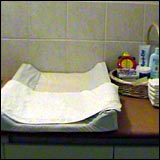
Make sure you have all the materials you need within your reach.

Let the child know that you are going to change their nappy. Always approach them from the front when picking them up or leading them to the change area.
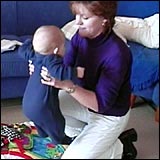
Lift the child onto the change mat, using the correct lifting techniques as specified by occupational health and safety standards.

Interact with the child, for example, smiling and talking continuously whilst changing their nappy.
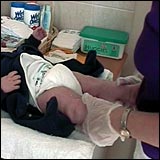
Undress the child then put gloves on to change their nappy. You should always wear gloves when changing soiled nappies or dealing with body fluids other than urine as specified by occupational health and safety standards.

Take the nappy off.
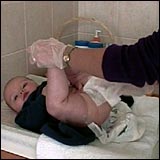
Using a cloth and warm soapy water clean in the creases of the baby's bottom, genitals and thighs. Place the used cloth into the cloth bucket and dry the baby with a clean cloth. Apply creams or lotions, if needed, using a cotton bud or cotton wool.
Note: When washing girls, you should wash with movements that wash away from the urethra. This means washing from front to back. This helps prevent infections of the urethra. When washing boys, you should not pull back the foreskin if the baby is not circumcised.
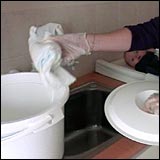
Dispose of the used nappy into a nappy bucket. You should use the sluice to remove the faeces before putting the nappy in the nappy bucket.
Remember! If the nappy is soiled, put gloves on if you haven't already done so.

Remove your gloves without touching the outside of the glove and place them in a bin as soon as the soiled nappy is removed to prevent the spread of infection.
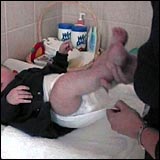
Lift the child's legs up gently to place clean nappy underneath the childs bottom. Put the baby's clothes back on, or replace them with clean clothes if necessary.

Wash the child's hands. Return the child to their play area.

Clean the change area with warm soapy water. If necessary, follow with bleach.
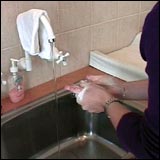
Wash and dry your hands.